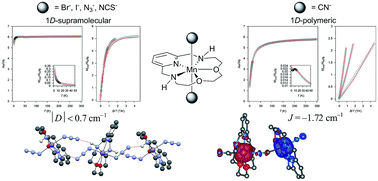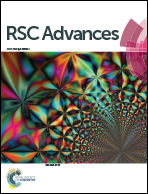Structural and magnetic properties of heptacoordinated MnII complexes containing a 15-membered pyridine-based macrocycle and halido/pseudohalido axial coligands†
Abstract
A series of heptacoordinated MnII compounds with a pentadentate 15-membered pyridine-based macrocycle 15-pyN3O2(3,12,18-triaza-6,9-dioxabicyclo[12.3.1]octadeca-1(18),14,16-triene) and two axially coordinated halido/pseudohalido coligands (X), having a monomeric [Mn(15-pyN3O2)X2] (X = Br− (1), I− (2), N3− (3), NCS− (4)) or polymeric {[Mn(15-pyN3O2)X](ClO4)}n (X = CN− (5)) composition, was prepared and thoroughly characterized. Single crystal X-ray analysis of 2, 3 and 4 determined the distorted pentagonal-bipyramidal geometry of the complexes. The analysis of the magnetic data of complexes 1–4 revealed non-zero values of the axial zero-field splitting parameter D (|D| < 0.7 cm−1) and weak antiferromagnetic intermolecular interactions (molecular field correction parameter zj ≈ −0.1 cm−1). As for the 1D polymeric complex 5, a small antiferromagnetic exchange coupling was found between MnII centres, with J = −1.72 cm−1. The experimentally obtained magnetic parameters (J or zj) were compared with those theoretically calculated at the DFT level in order to reveal the magnetic exchange pathways in 2–4 and to support the polymeric structure of 5 (JEXP = −2.79 cm−1vs. JR/JY = −2.54/−3.06 cm−1, when the dinuclear spin Hamiltonian was used). It has been also found that extensive systems of hydrogen bonds, non-covalent contacts and π–π stacking interactions present in the crystal structures of 2, 3 and 4 have an impact on the formation of supramolecular 1D chains, and as a consequence of this on the magnetic properties of the complexes. Contrary to non-covalent contacts, the influence of the axial ligands on the magnetic nature of the complexes seems to be negligible.



 Please wait while we load your content...
Please wait while we load your content...